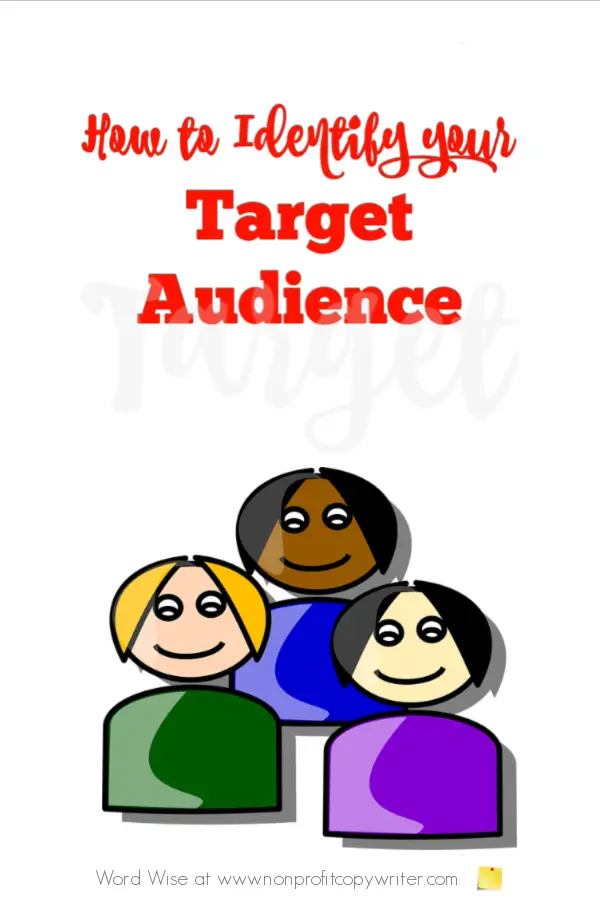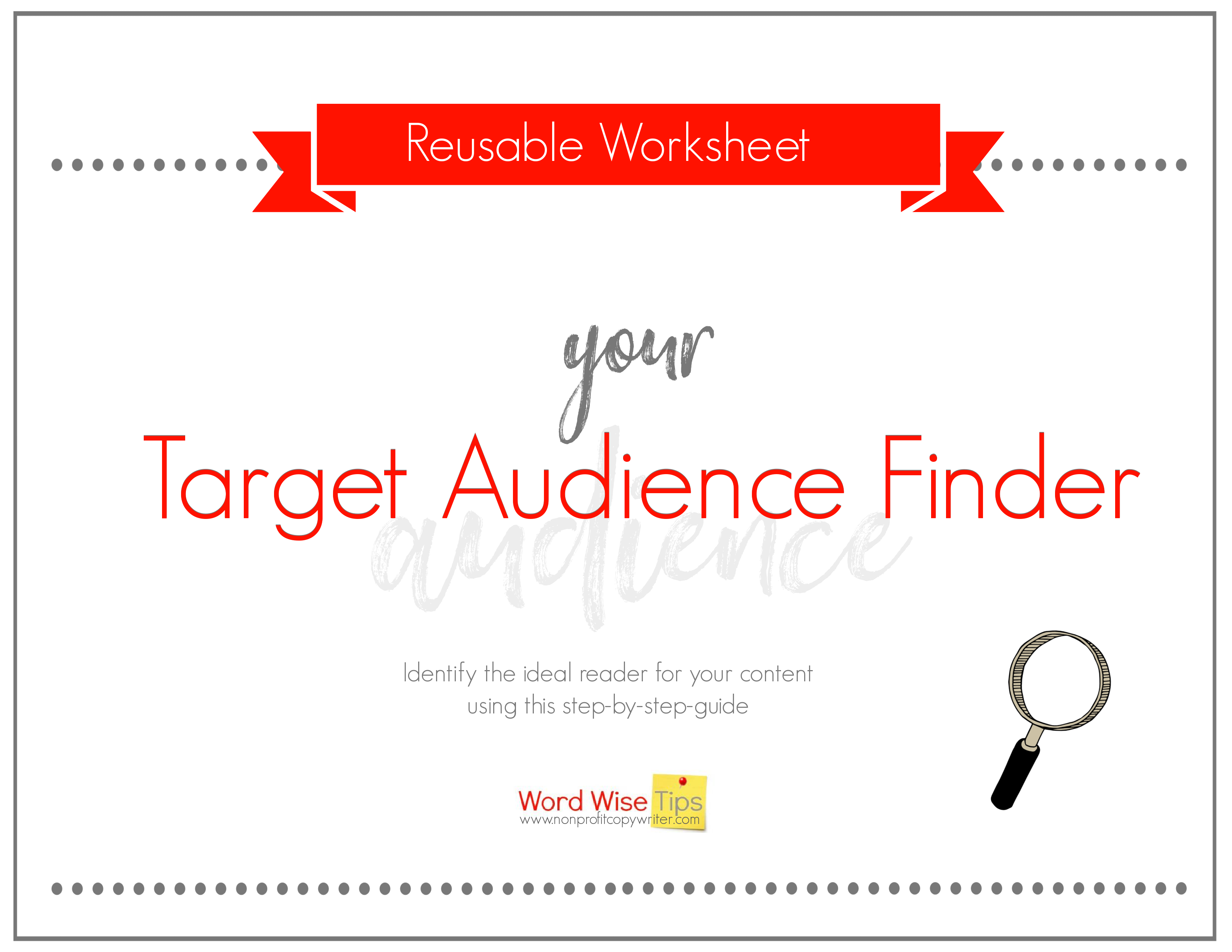Save Time: Get 5 Simple Writing Tips
you can put to use in 10 minutes
Your Target Audience: Here's How To ID Them
Award-winning writer Kathy Widenhouse has helped hundreds of nonprofits and writers produce successful content , with 750K+ views for her writing tutorials. She is the author of 9 books. See more of Kathy’s content here.
Updated 1.13.26
Your target audience is a specific group of people most likely to respond positively to your content.
The reason they respond is simple. You give them content that they really, really need or want.
So it follows that in order to serve your target audience, you need to identify who they are – what they like, what they dislike, what makes their blood boil, what gives them a shiver, what excites them – so you can direct your content to them.
In fact, it’s a good idea to create an ideal reader profile before you write your piece of content. Some folks call this a customer avatar. It’s a description of a typical member of your target readership. (Here’s how to create an ideal reader profile.)
But here’s a side note: you have more than one target audience.
I’m sure you knew this intuitively, but isn’t it nice to have a friend spell it out for you?
Once I learned this truth, I felt relieved. It was as if I’d been trying hard to identify just one customer avatar for ALL of my projects and somehow, that didn’t work so well. (Duh!)
If you’re a freelancer – or any kind of ministry writer, for that matter – you switch hats and write to different kinds of readers to reach these multiple targets. Here’s what I mean.
Target Audience #1: Your Personal Readers
There’s a good chance you write a personal blog or eBooks or newsletter or maintain a website or produce your own content of some type.
Who are your readers? Yes, create a reader profile.
But more importantly, identify the difference you make for them by writing your content. Put yourself inside Rachel Reader when you write each post, each page, and each issue.
For instance, let’s say you write a blog for parents who raise children with learning disabilities. Your reader profile describes your average subscriber as a mom in her 30’s who is raising a child with either dyslexia or dysgraphia. She frequently experiences despair for her child’s future and doesn’t know where to turn to get practical help. Her greatest needs are encouragement and resources.
As you create posts and other content, this persona is front and center in your mind. You write directly to her. And because you are focused on meeting her needs, your content helps her child to flourish and transforms this mom’s own frustration into victory.
Since you understand this reader and her child’s LD, your content is not only relevant and valuable for this reader. It’s also transformational.
You’re writing to this audience for life change.
Target Audience #2: Your Prospects
Let’s continue our scenario further and speculate that your blog leads you to specialize in freelance writing for the special needs and parenting niches.
Meaning you must change gears occasionally and write different kinds of projects (such as prospecting letters) to a different target audience (potential clients).
So you write out a reader profile for this target: ministries, blogs, and organizations that provide products and services for parents and families. Leaders in these organizations look for good writers who understand their issues. Many of these organizations are small to mid-size, so their staffers are pressed for time. Maybe they know they need a content writer; maybe they have never outsourced content but would grab the opportunity if presented with it by a supportive, qualified freelancer (you).
Make sure you switch gears as you write to Target Audience #2. Put yourself in her shoes. Your content communicates your familiarity with the target reader’s niche, but you focus on her greater need: being an outsource provider who is reliable and professional.
Your prospecting letters point to the fact that you “get” her. You free her to have more time to do the work of her ministry.
You’re writing to this audience to provide a service.
Target Audience #3, #4, #5, and More: Your Client’s Readers
If you write for other clients, you need to pick their brains and discover their target audience.
They’ll have more than one, just as you do.
If you’re a leader, you transition intuitively among your target groups in your daily conversations and often don’t know that you flex so easily. If you’re a freelancer, you need to understand that your client – the leader – switches gears almost without thinking.
What does this mean?
Remember who you’re writing for: your client. You communicate the client’s message clearly to her target audience and get them to respond.
Identify who you are writing to: the primary (and secondary) target.
Big difference.
Identify Multiple Target Audiences
Let’s say you’re getting ready to write a piece of content for your readers. Or you’re a freelancer and you get an assignment from a new client (Yay!)
Before you figure out the structure of the appeal letter or types of articles you need to write for the newsletter … before you start gathering anecdotes and facts … before you begin interviews for testimonials … before you begin writing one word, you do what any other high-quality content writer would do. You create a target reader profile.
But you run into a problem. Who is the target reader of this particular piece? What action does your client want that reader to take as a result of reading the piece?
Identify Which Audience This Piece Will Target
Leaders may not be aware that any piece of written content, to be successful, must target one audience. Repeat: just one.
That’s not to say that a web page or a social media post or any other project cannot speak to more than one kind of target reader. It can. It will. In fact, your project may have a primary target reader and one or more secondary target readers.
But make sure you’re clear on who those groups are.
For instance, let’s say a camp director hires you to write a brochure for a summer program for children with learning disabilities. Who will read the brochure and what does the client want that reader to do as a result? Your client’s big-picture target audience are those who are interested in equipping children and families to overcome learning disabilities. Yet even within this group, you’ll find a wide variance.
- Target Reader #1 are parents who enroll their children in the camp. They need to know that their children will be safe and want to know how their children will be different and better after the experience.
- Target Reader #2 are school administrators, teachers, and therapists who refer families to the camp. They want the camp to reinforce the progress that students have made throughout the academic year.
- Target Reader #3 are donors who support the camp. They have a personal connection to the learning disabilities issue, whether they’ve overcome one on their own or have a family member who has dealt with an LD. They want to know that the staff is comprised of innovative, top-notch pros who will deliver a quality program that’s worth their investment.
- Target Reader #4 are campers. They want to have fun.
- Other targets could be potential camp employees or camp alumni …
See what I mean?
Pick your client’s brain to make sure you’re writing to a clear group so target readers (and even a secondary target group) and what action your clients wants that reader to take as a result of reading the piece.
Don’t assume the client will make this distinction for you. Ask. Probe. Search. Investigate.
When it comes to writing content for someone other than yourself, be sure you understand an important distinction.
You’re writing for your client. But you’re writing to the primary (and secondary) target.
Can you identify the audiences you write for?
More Freelance Writing Tips
Who Is the Target Audience for Your Content? Here's how to find out ...
Identify Your Audience With These 3 Questions ...
Don’t Be A Writer For Everyone. Choose Your Niche Audience...
Want More Readers? Use the Know Like Trust Principle ...
Want More Traffic? Cross-Posting Is Easy ...
3 Ways to Build an Audience for Next to Nothing ...
Know Your Audience Before You Write ...
Use this Target Audience Finder worksheet to identify your ideal reader ...
50 Copywriting Terms Every Writer Should Know ...
The Best Lead Magnet Does One Thing ...
Should You Specialize in a Freelance Content Writing Niche?
3 Tips in Getting Freelance Writing Assignments ...
6 Writing Tips for Starting Out as a Freelancer ...
Don’t Market Your Writing. Do This Instead...
Is It a Feature or Benefit? How to Write Benefits ...
Point of View (POV) Explained ...
More basic copywriting tips on our Pinterest board ...
More tips for freelance writers on our Pinterest board ...
Return from Target Audience: How to ID Them to Nonprofit Copywriter home
As an Amazon Associate I earn from qualifying purchases.
Share This Page

Named to 2022 Writer's Digest list
BEST GENRE/NICHE WRITING WEBSITE


Stop Wasting Time!
Grab your exclusive FREE guide, "5 Simple Writing Tips You Can Put to Use in 10 Minutes or Less"













